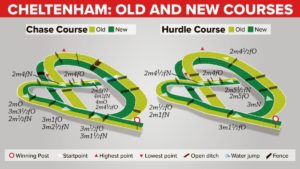Just how ‘new’ is the New Course at Cheltenham?
 The short answer is not particularly. In its current configuration, the New Course was first used in 1967 – the year Woodland Venture, trained by Fred Rimell and ridden by Terry Biddlecombe, won the Cheltenham Gold Cup – so is really only ‘new’ in relation to the original Old Course.
The short answer is not particularly. In its current configuration, the New Course was first used in 1967 – the year Woodland Venture, trained by Fred Rimell and ridden by Terry Biddlecombe, won the Cheltenham Gold Cup – so is really only ‘new’ in relation to the original Old Course.
Every March, when the Cheltenham Festival rolls around, plenty of column inches are devoted to the differences between the Old Course and the New Course at Prestbury Park. The New Course, which is in use on the final two days of the Festival, is a left-handed, undulating oval which, like the Old Course, is galloping and testing in character.
The New Course runs parallel to the Old Course for much of the way but, at its highest point, furthest from the grandstands, takes a wider loop back towards the winning post. Thus, runners enter the home straight slightly further from the winning post than on the Old Course, which places even more emphasis on stamina. It should come as no surprise that the longer feature races on the third and fourth days of the Festival, the Stayers’ Hurdle and the Cheltenham Gold Cup, are run on the New Course. Retired jockey Barry Geraghty, who rode 43 winners at the Cheltenham Festival, said, ‘It is as simple as this really; the Old Course is all speed, the New Course is all stamina.’